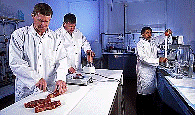United States Department of Agriculture: Agricultural Research Service, Lincoln, Nebraska

Roman L. Hruska U.S. Meat Animal Research Center: Reports
Date of this Version
1993
Document Type
Article
Abstract
Fetal growth, as indicated by birth weight, has important influences on animal production. Birth weights lower than optimum are associated with reduced energy reserves, lowered thermoregulatory capability, and increased calf deaths at or near birth. In addition, low birth weights are related to low rates of growth after birth and decreased mature size. Conversely, birth weights greater than optimum are associated with greater calving difficulty. Primarily because of the increased calving difficulty, calf losses at birth and difficulties if rebreeding the cow are increased.
Fetal growth, hence birth weight, is influenced by numerous factors including number of fetuses, sex, parity or age of the cow, breed of sire, breed of dam, heat or cold stress, and nutrition. The importance of these and other effectors of fetal growth vary. In general, however, birth weight of each fetus decreases with increased numbers of fetuses, is greater for males than for females, and increases with age or parity of the cow. Birth weights are decreased by heat or inadequate nutrition, and increased by cold. Both the sire and dam contribute to differences in genetic potential for growth, but it is evident that the dam exerts an influence beyond her contribution to fetal genotype.
It is important to know what the factors are that affect fetal growth and their potential magnitude. In order to minimize adverse effects of factors influencing fetal growth, it is perhaps more important to understand how and why differences in fetal growth and birth weight occur. The following sections will summarize several experiments conducted to develop a better understanding of some of the major factors affecting fetal growth.


Comments
Published in Beef Research Program Progress Report (1993) No. 4 (Part 1): 104-107